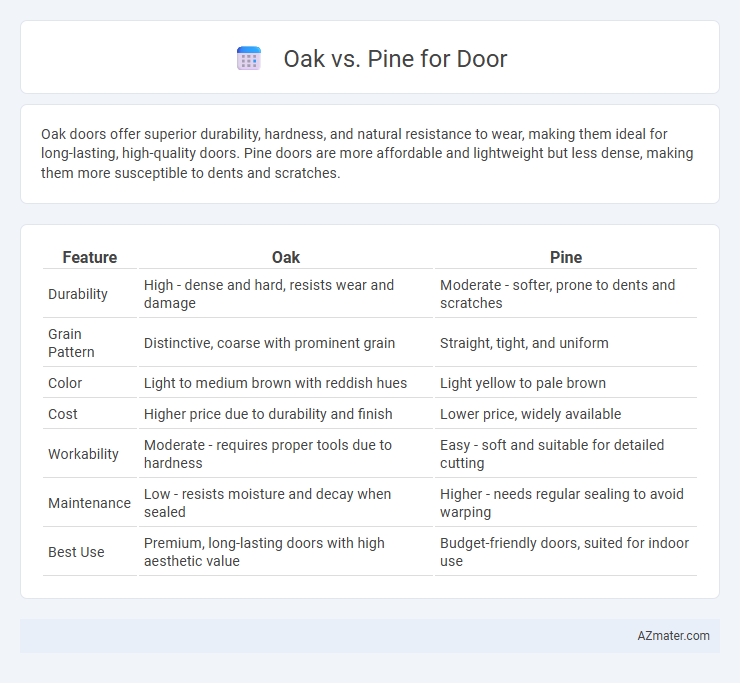Oak doors offer superior durability, hardness, and natural resistance to wear, making them ideal for long-lasting, high-quality doors. Pine doors are more affordable and lightweight but less dense, making them more susceptible to dents and scratches.
Table of Comparison
| Feature | Oak | Pine |
|---|---|---|
| Durability | High - dense and hard, resists wear and damage | Moderate - softer, prone to dents and scratches |
| Grain Pattern | Distinctive, coarse with prominent grain | Straight, tight, and uniform |
| Color | Light to medium brown with reddish hues | Light yellow to pale brown |
| Cost | Higher price due to durability and finish | Lower price, widely available |
| Workability | Moderate - requires proper tools due to hardness | Easy - soft and suitable for detailed cutting |
| Maintenance | Low - resists moisture and decay when sealed | Higher - needs regular sealing to avoid warping |
| Best Use | Premium, long-lasting doors with high aesthetic value | Budget-friendly doors, suited for indoor use |
Introduction to Oak and Pine Doors
Oak doors offer exceptional durability and a rich, warm grain pattern that enhances both traditional and modern interiors. Pine doors provide a lightweight, budget-friendly option with a distinctive yellowish tone and smooth texture, suitable for various design styles. Both woods are popular for door construction due to their strength and aesthetic appeal, with oak favored for long-lasting hardness and pine valued for ease of customization.
Key Differences Between Oak and Pine Wood
Oak and pine differ significantly in hardness, with oak rated around 1290 on the Janka hardness scale compared to pine's 420, making oak more durable for door construction. Oak has a tighter grain pattern and richer natural color variations, while pine features a lighter, more uniform appearance with prominent knots. Moisture resistance is higher in oak, reducing warping and swelling over time, whereas pine requires more maintenance to prevent damage in humid environments.
Durability: Oak vs Pine for Doors
Oak doors offer superior durability due to their dense grain and hardwood composition, making them highly resistant to dents and wear over time. Pine doors, while more affordable and easier to work with, are softer and more prone to scratches, dents, and damage from moisture. The robust nature of oak ensures long-term resilience and minimal maintenance compared to the relatively less durable pine doors.
Aesthetic Appeal: Grain and Color Comparison
Oak doors exhibit a prominent grain pattern with rich, warm hues ranging from light amber to deep brown, offering a classic and sophisticated aesthetic. Pine doors possess a softer, lighter color palette, often creamy white to pale yellow, with a subtle grain that lends a rustic and casual charm. The choice between oak and pine significantly impacts the door's visual texture and ambiance, with oak favored for elegance and pine for a more relaxed, natural look.
Cost Comparison: Oak vs Pine Doors
Oak doors typically cost more than pine doors due to the hardwood's superior density and durability, with prices averaging $300 to $800 per door compared to pine's $100 to $400 range. The higher cost of oak reflects its resistance to wear, greater stability, and elegant grain patterns, making it a popular choice for premium interior and exterior doors. Pine, being a softwood, is more affordable and easier to work with, but it may require more frequent maintenance and refinishing over time.
Maintenance Requirements of Oak and Pine
Oak doors demand minimal maintenance due to their dense grain and natural resistance to moisture and insects, often requiring only periodic sealing or oiling to maintain their durability. Pine doors are softer and more porous, necessitating regular painting or staining to protect against dents, scratches, and weather damage. Both woods benefit from routine inspections, but oak's resilience results in lower long-term upkeep compared to pine's higher susceptibility to wear and environmental factors.
Environmental Impact and Sustainability
Oak doors offer greater durability and a longer lifespan, reducing the need for frequent replacement and minimizing environmental waste. Pine is faster-growing and more renewable, making it a more sustainable choice with a lower carbon footprint during production. Choosing oak supports sustainable forestry management, while pine's rapid growth contributes to carbon sequestration and faster ecosystem recovery.
Suitability for Different Home Styles
Oak doors suit traditional and rustic home styles with their rich grain and durability, enhancing classic or craftsman aesthetics. Pine doors, lighter and more affordable, complement casual, cottage, or coastal interiors with a softer, warm look that can be easily painted or stained. Selecting oak or pine depends on desired durability, grain appearance, and budget aligned with the home's architectural style.
Popular Uses of Oak and Pine Doors
Oak doors are favored for their exceptional durability and rich grain patterns, making them ideal for high-traffic interior and exterior applications in traditional and rustic homes. Pine doors, prized for their affordability and lightweight nature, are commonly used in budget-friendly interiors, including closet and pantry doors, where ease of customization and painting is essential. Both woods enhance door aesthetics and functionality but cater to different style preferences and durability requirements.
Final Verdict: Choosing Between Oak and Pine for Doors
Oak doors offer superior durability, natural resistance to wear, and a rich, attractive grain that enhances aesthetic appeal, making them ideal for high-traffic or exterior entrance doors. Pine doors provide a budget-friendly, lightweight option with easier customization through staining or painting, suitable for interior doors with less exposure to heavy use. The final verdict depends on balancing budget constraints and desired durability: choose oak for strength and longevity, or pine for affordability and versatility.

Infographic: Oak vs Pine for Door
 azmater.com
azmater.com